Abstract
Sixty-one patients with a variety of different illnesses were studied with respect to skin test anergy and the presence of serum chemotactic inhibitors. In initial testing, 55% of the patient tests demonstrated negative skin test responses to all six test antigens. Sera from 65% of these anergic patients were capable of suppressing the migration of normal polymorphonuclear leukocytes toward chemotactic factors. Statistical analysis of the association of anergy and chemotactic inhibitory sera resulted in a P value of <0.0005. Chemotactic inhibitory sera were also capable of suppressing monocyte chemotaxis. No association of chemotactic inhibitory activity and lymphocytotoxic antibody or suppressors of mitogen-induced lymphocyte blast transformation were noted. In addition, T-cell populations in some anergic patients were studied by the erythrocyte-binding technique. Erythrocyte-binding lymphocytes in anergic patients were significantly suppressed when compared to normal controls, but not when compared to skin test-positive patients. The data presented here indicate a close parallel between skin test anergy and the presence of serum chemotactic inhibitory activity. The exact relationship is yet undefined but may indicate the involvement of chemotactic inhibitors as immunological regulators in the host during a variety of systemic illnesses.
Full text
PDF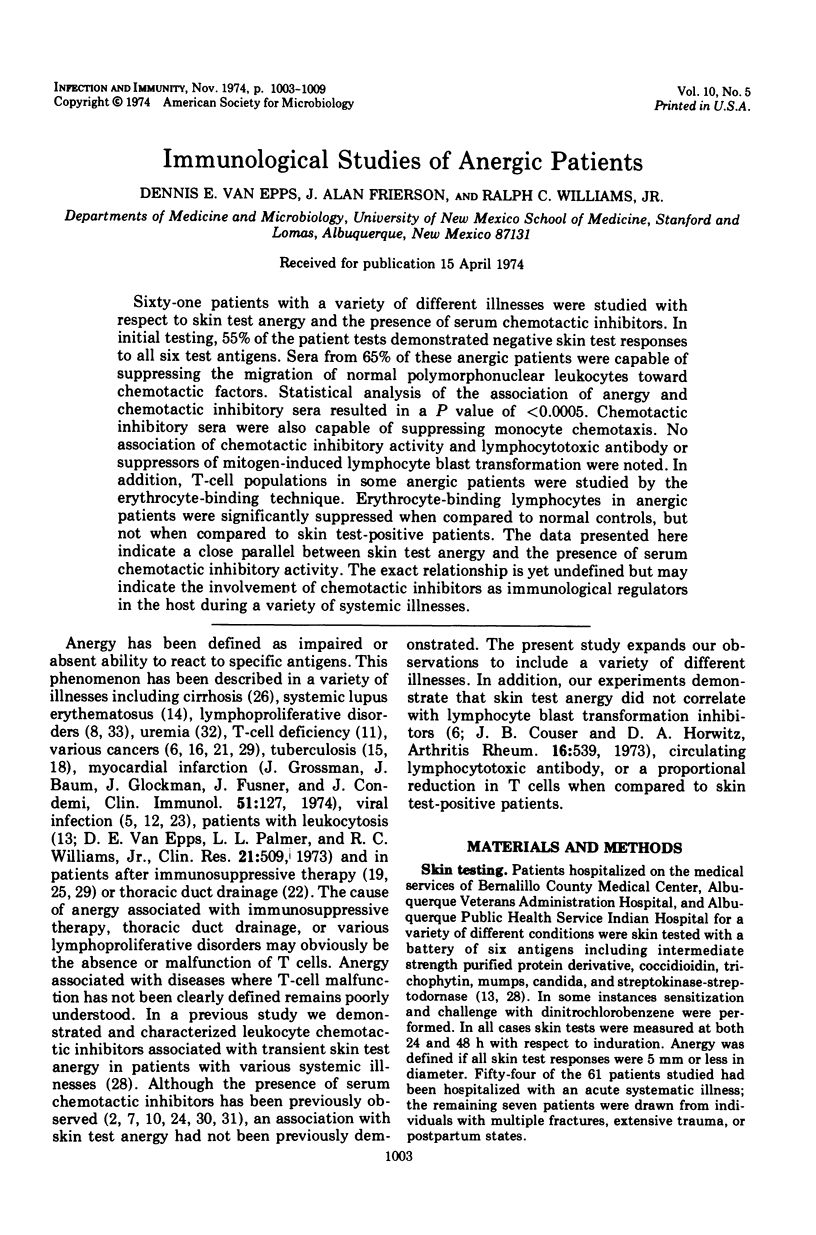
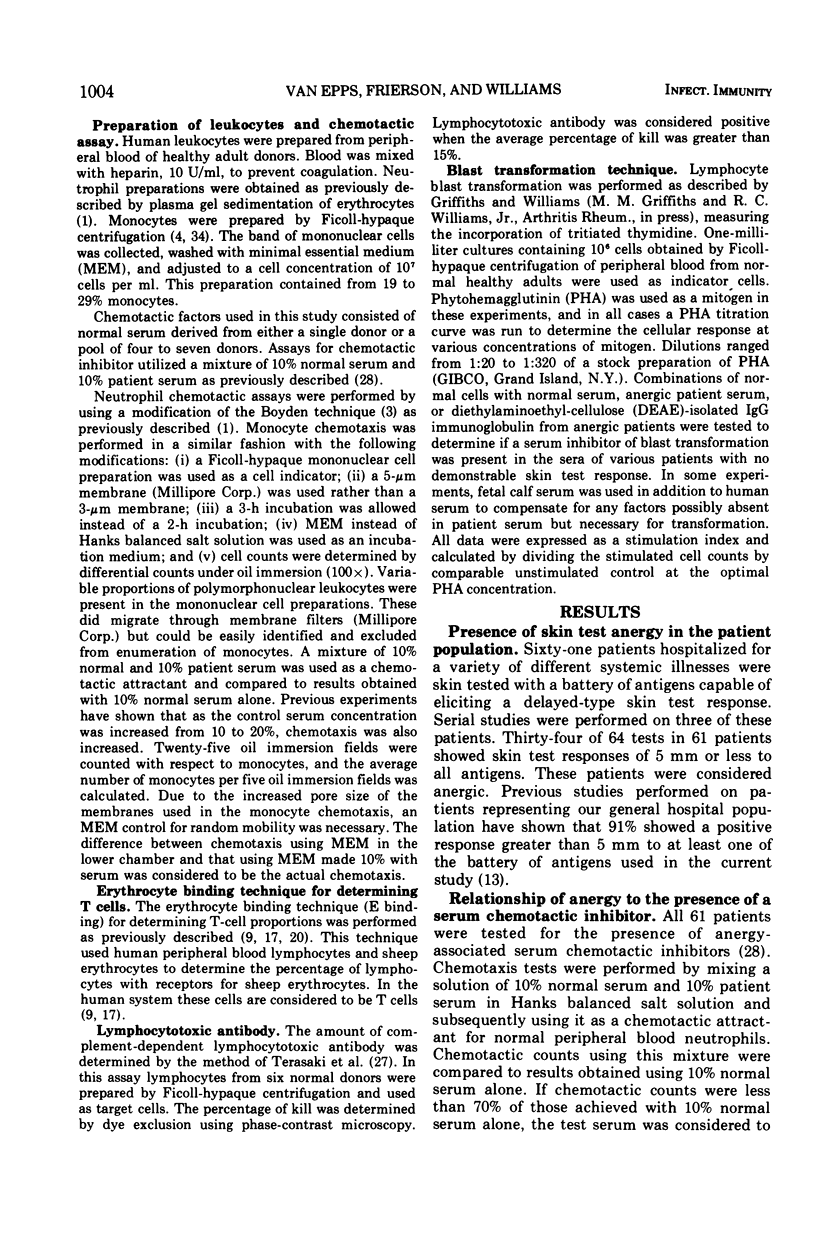
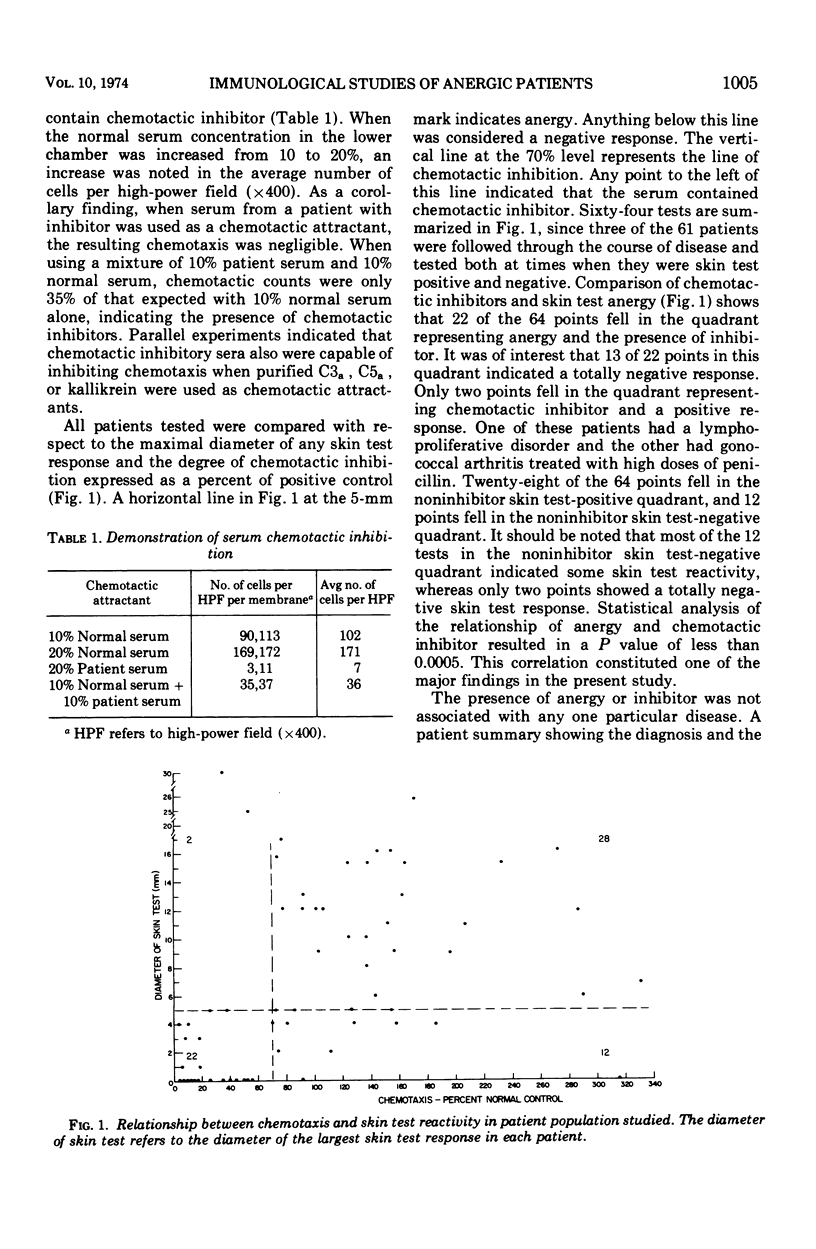
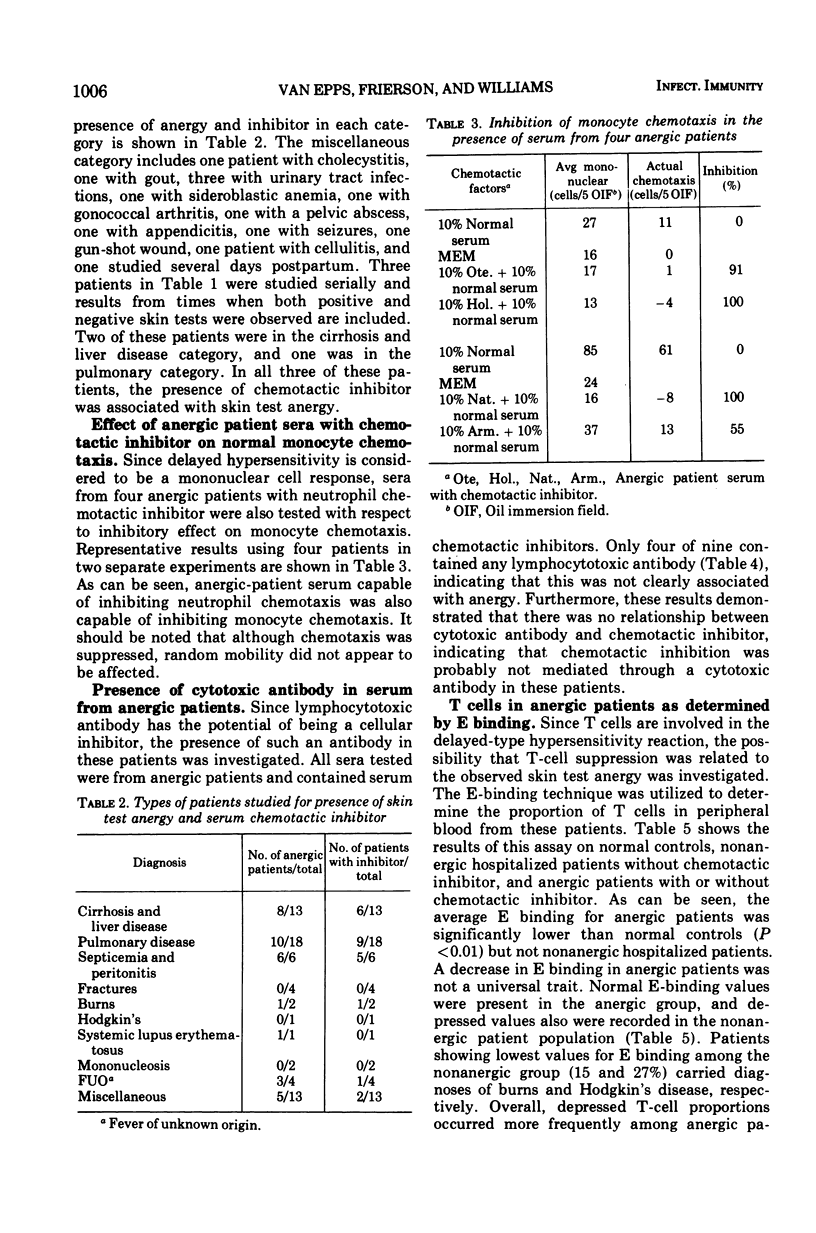
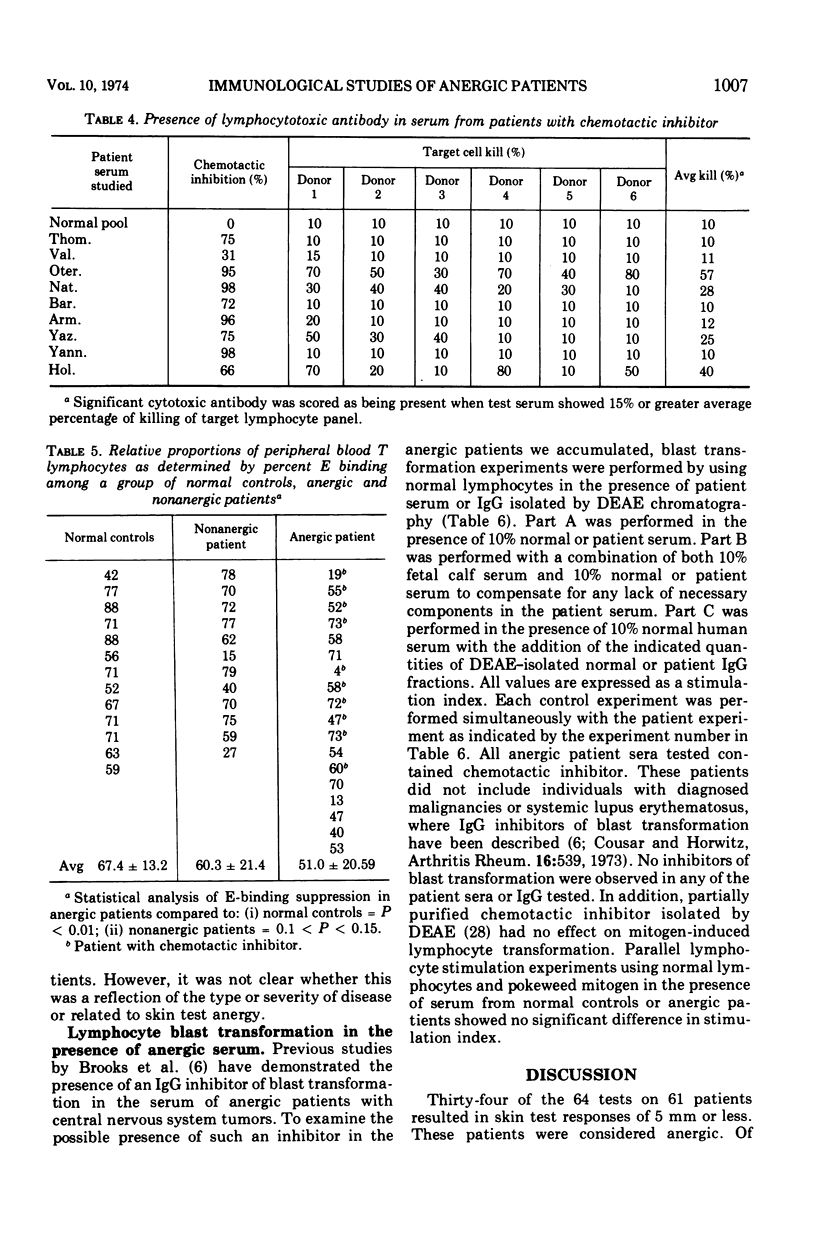
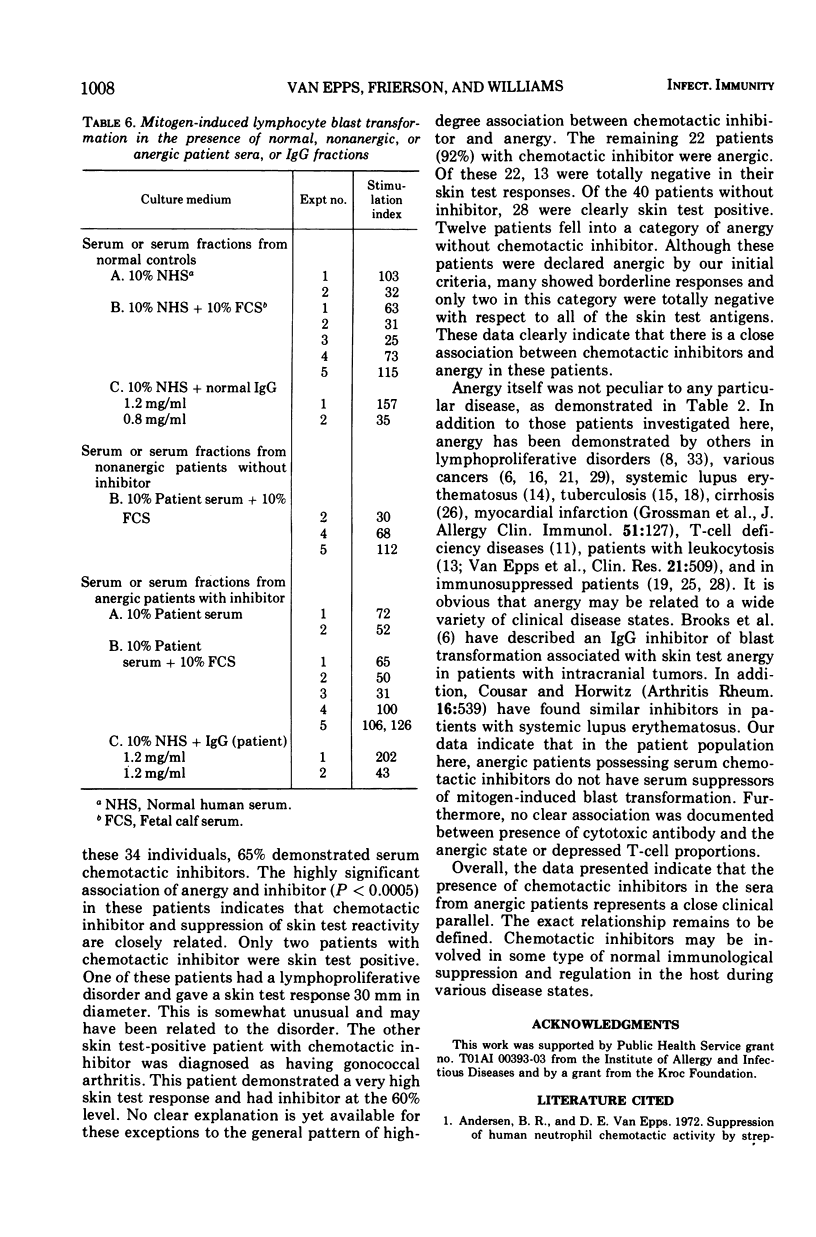
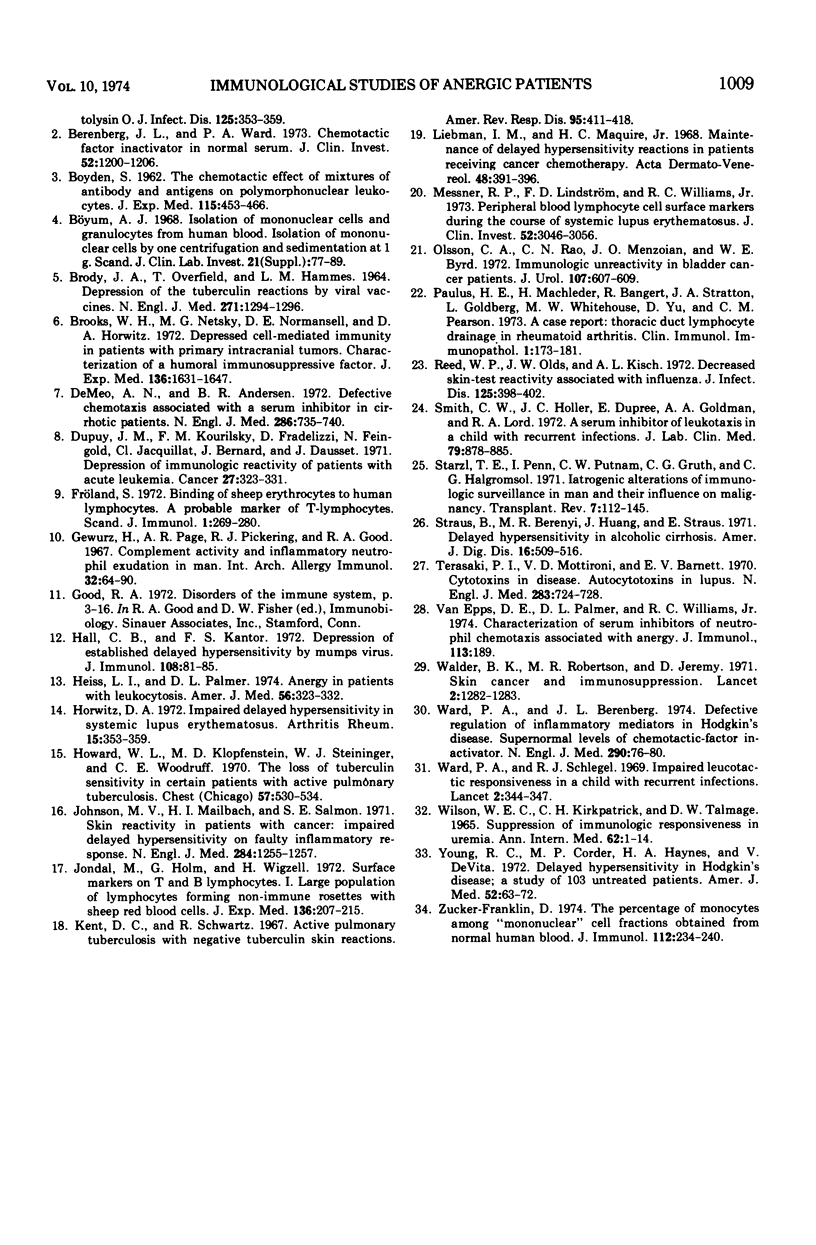
Selected References
These references are in PubMed. This may not be the complete list of references from this article.
- Andersen B. R., Van Epps D. E. Suppression of chemotatic activity of human neutrophils by streptolysin O. J Infect Dis. 1972 Apr;125(4):353–359. doi: 10.1093/infdis/125.4.353. [DOI] [PubMed] [Google Scholar]
- BOYDEN S. The chemotactic effect of mixtures of antibody and antigen on polymorphonuclear leucocytes. J Exp Med. 1962 Mar 1;115:453–466. doi: 10.1084/jem.115.3.453. [DOI] [PMC free article] [PubMed] [Google Scholar]
- BRODY J. A., OVERFIELD T., HAMMES L. M. DEPRESSION OF THE TUBERCULIN REACTION BY VIRAL VACCINES. N Engl J Med. 1964 Dec 17;271:1294–1296. doi: 10.1056/NEJM196412172712505. [DOI] [PubMed] [Google Scholar]
- Berenberg J. L., Ward P. A. Chemotactic factor inactivator in normal human serum. J Clin Invest. 1973 May;52(5):1200–1206. doi: 10.1172/JCI107287. [DOI] [PMC free article] [PubMed] [Google Scholar]
- Brooks W. H., Netsky M. G., Normansell D. E., Horwitz D. A. Depressed cell-mediated immunity in patients with primary intracranial tumors. Characterization of a humoral immunosuppressive factor. J Exp Med. 1972 Dec 1;136(6):1631–1647. doi: 10.1084/jem.136.6.1631. [DOI] [PMC free article] [PubMed] [Google Scholar]
- Böyum A. Isolation of mononuclear cells and granulocytes from human blood. Isolation of monuclear cells by one centrifugation, and of granulocytes by combining centrifugation and sedimentation at 1 g. Scand J Clin Lab Invest Suppl. 1968;97:77–89. [PubMed] [Google Scholar]
- DeMeo A. N., Andersen B. R. Defective chemotaxis associated with a serum inhibitor in cirrhotic patients. N Engl J Med. 1972 Apr 6;286(14):735–740. doi: 10.1056/NEJM197204062861401. [DOI] [PubMed] [Google Scholar]
- Dupuy J. M., Kourilsky F. M., Fradelizzi D., Feingold N., Jacquillat C., Bernard J., Dausset J. Depression of immunologic reactivity of patients with acute leukemia. Cancer. 1971 Feb;27(2):323–331. doi: 10.1002/1097-0142(197102)27:2<323::aid-cncr2820270212>3.0.co;2-m. [DOI] [PubMed] [Google Scholar]
- Fröland S. S. Binding of sheep erythrocytes to human lymphocytes. A probable marker of T lymphocytes. Scand J Immunol. 1972;1(3):269–280. doi: 10.1111/j.1365-3083.1972.tb01818.x. [DOI] [PubMed] [Google Scholar]
- Gewurz H., Page A. R., Pickering R. J., Good R. A. Complement activity and inflammatory neutrophil exudation in man. Studies in patients with glomerulonephritis, essential hypocomplementemia and agammaglobulinemia. Int Arch Allergy Appl Immunol. 1967;32(1):64–90. doi: 10.1159/000229917. [DOI] [PubMed] [Google Scholar]
- Hall C. B., Kantor F. S. Depression of established delayed hepersensitivity by mumps virus. J Immunol. 1972 Jan;108(1):81–85. [PubMed] [Google Scholar]
- Heiss L. I., Palmer D. L. Anergy in patients with leukocytosis. Am J Med. 1974 Mar;56(3):323–332. doi: 10.1016/0002-9343(74)90614-7. [DOI] [PubMed] [Google Scholar]
- Horwitz D. A. Impaired delayed hypersensitivity in systemic lupus erythematosus. Arthritis Rheum. 1972 Jul-Aug;15(4):353–359. doi: 10.1002/art.1780150406. [DOI] [PubMed] [Google Scholar]
- Howard W. L., Klopfenstein M. D., Steininger W. J., Woodruff C. E. The loss of tuberculin sensitivity in certain patients with active pulmonary tuberculosis. Chest. 1970 Jun;57(6):530–534. doi: 10.1378/chest.57.6.530. [DOI] [PubMed] [Google Scholar]
- Johnson M. W., Maibach H. I., Salmon S. E. Skin reactivity in patients with cancer. Impaired delayed hypersensitivity or faulty inflammatory response? N Engl J Med. 1971 Jun 3;284(22):1255–1257. doi: 10.1056/NEJM197106032842210. [DOI] [PubMed] [Google Scholar]
- Jondal M., Holm G., Wigzell H. Surface markers on human T and B lymphocytes. I. A large population of lymphocytes forming nonimmune rosettes with sheep red blood cells. J Exp Med. 1972 Aug 1;136(2):207–215. doi: 10.1084/jem.136.2.207. [DOI] [PMC free article] [PubMed] [Google Scholar]
- Kent D. C., Schwartz R. Active pulmonary tuberculosis with negative tuberculin skin reactions. Am Rev Respir Dis. 1967 Mar;95(3):411–418. doi: 10.1164/arrd.1967.95.3.411. [DOI] [PubMed] [Google Scholar]
- Liebman I. M., Maguire H. C., Jr Maintenance of delayed hypersensitivity reactions in patients receiving cancer chemotherapy. Acta Derm Venereol. 1968;48(5):391–396. [PubMed] [Google Scholar]
- Messner R. P., Lindström F. D., Williams R. C., Jr Peripheral blood lymphocyte cell surface markers during the course of systemic lupus erythematosus. J Clin Invest. 1973 Dec;52(12):3046–3056. doi: 10.1172/JCI107503. [DOI] [PMC free article] [PubMed] [Google Scholar]
- Olsson C. A., Rao C. N., Menzoian J. O., Byrd W. E. Immunologic unreactivity in bladder cancer patients. J Urol. 1972 Apr;107(4):607–609. doi: 10.1016/s0022-5347(17)61090-5. [DOI] [PubMed] [Google Scholar]
- Paulus H. E., Machleder H., Bangert R., Stratton J. A., Goldberg L., Whitehouse M. W., Yu D., Pearson C. M. A case report: thoracic duct lymphocyte drainage in rheumatoid arthritis. Clin Immunol Immunopathol. 1973 Jan;1(2):173–181. doi: 10.1016/0090-1229(73)90017-2. [DOI] [PubMed] [Google Scholar]
- Reed W. P., Olds J. W., Kisch A. L. Decreased skin-test reactivity associated with influenza. J Infect Dis. 1972 Apr;125(4):398–402. doi: 10.1093/infdis/125.4.398. [DOI] [PubMed] [Google Scholar]
- Smith C. W., Hollers J. C., Dupree E., Goldman A. S., Lord R. A. A serum inhibitor of leukotaxis in a child with recurrent infections. J Lab Clin Med. 1972 Jun;79(6):878–885. [PubMed] [Google Scholar]
- Starzl T. E., Penn I., Putnam C. W., Groth C. G., Halgrimson C. G. Iatrogenic alterations of immunologic surveillance in man and their influence on malignancy. Transplant Rev. 1971;7:112–145. doi: 10.1111/j.1600-065x.1971.tb00465.x. [DOI] [PMC free article] [PubMed] [Google Scholar]
- Straus B., Berenyi M. R., Huang J. M., Straus E. Delayed hypersensitivity in alcoholic cirrhosis. Am J Dig Dis. 1971 Jun;16(6):509–516. doi: 10.1007/BF02235541. [DOI] [PubMed] [Google Scholar]
- Terasaki P. I., Mottironi V. D., Barnett E. V. Cytotoxins in disease. Autocytotoxins in lupus. N Engl J Med. 1970 Oct 1;283(14):724–728. doi: 10.1056/NEJM197010012831403. [DOI] [PubMed] [Google Scholar]
- Van Epps D. E., Palmer D. L., Williams R. C., Jr Characterization of serum inhibitors of neutrophil chemotaxis associated with anergy. J Immunol. 1974 Jul;113(1):189–200. [PubMed] [Google Scholar]
- Walder B. K., Robertson M. R., Jeremy D. Skin cancer and immunosuppression. Lancet. 1971 Dec 11;2(7737):1282–1283. doi: 10.1016/s0140-6736(71)90602-7. [DOI] [PubMed] [Google Scholar]
- Ward P. A., Berenberg J. L. Defective regulation of inflammatory mediators in Hodgkin's disease. Supernormal levels of chemotactic-factor inactivator. N Engl J Med. 1974 Jan 10;290(2):76–80. doi: 10.1056/NEJM197401102900203. [DOI] [PubMed] [Google Scholar]
- Ward P. A., Schlegel R. J. Impaired leucotactic responsiveness in a child with recurrent infections. Lancet. 1969 Aug 16;2(7616):344–347. doi: 10.1016/s0140-6736(69)92699-3. [DOI] [PubMed] [Google Scholar]
- Young R. C., Corder M. P., Haynes H. A., DeVita V. T. Delayed hypersensitivity in Hodgkin's disease. A study of 103 untreated patients. Am J Med. 1972 Jan;52(1):63–72. doi: 10.1016/0002-9343(72)90008-3. [DOI] [PubMed] [Google Scholar]
- Zucker-Franklin D. The percentage of monocytes among "mononuclear" cell fractions obtained from normal human blood. J Immunol. 1974 Jan;112(1):234–240. [PubMed] [Google Scholar]


